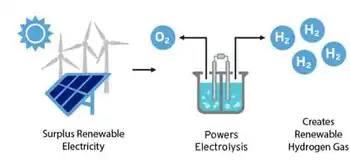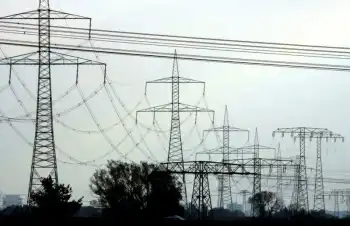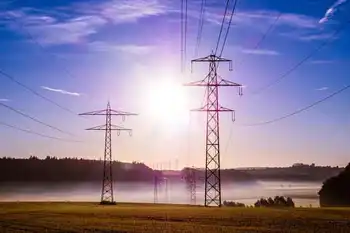Pilot plant a learning tool for carbon capture
By Charleston Daily Mail
High Voltage Maintenance Training Online
Our customized live online or in‑person group training can be delivered to your staff at your location.

- Live Online
- 12 hours Instructor-led
- Group Training Available
Alstom, a global company headquartered in France, is building the pilot plant next to a coal-fired boiler on Blaine Island in The Dow Chemical Co.'s South Charleston plant.
The pilot plant will capture about 1,800 tons of carbon dioxide a year from the flue gas that comes off the boiler, which is the only coal-fired boiler Dow owns in the United States.
Under a joint development agreement, Alstom designed the pilot plant, is constructing it and will operate it. Dow provided the site and the utilities and will supply Dow's proprietary amines — a class of chemicals derived from ammonia.
Bob Hilton, Alstom's vice president of power technologies for government affairs, said Dow has for years used its amines on natural gas wells.
"What's unique here is to optimize the amine given the chemical environment the flue gas presents," Hilton said. "There are constituents in flue gas that can have an impact on the amine which are not present in a lot of other environments. For example, there's a lot of oxygen, which can degrade the amine. Dow is refining an advanced amine that is particularly resistant to oxygen. What we want to do in the pilot is measure how selected formulas work and measure the energy requirements. It's a first-of-a-kind application because no one has used it in this particular chemical setting."
Alstom won't disclose how much is being invested in the pilot project other than to say it's in the millions of dollars. Hilton said, "What you don't see is, Dow and Alstom have made a large investment in software simulating the process. Part of what this program is designed to do is to prove that the system as we built it matches the computer simulations we've developed. It will prove that the simulations are correct, so we won't have to build a lot of little pilot plants."
The pilot also will measure performance.
Project manager David Schmidt said the plant will be computer-controlled and heavily instrumented with analytical work done on site.
Hilton said, "We'll want to prove out the process at various points, such as removing 50 percent of the carbon dioxide versus 70 percent or 90 percent. There's always a sweet spot, an economic optimum. You want to understand the economics of the capture curve, the utilization of amine and energy."
The cost of removing carbon dioxide from a power plant or, in this case a coal-fired boiler used to generate steam, is considered an energy loss.
"Obviously when you put this on a power plant it's just a cost of doing business," Hilton said. "The way the world will see it is, what is the impact on the cost of electricity?"
Hilton declined to say how much the amines carbon capture technology might add to the cost of a power plant because "we're still learning," and every time someone provides a number, "it fuels speculation." Obviously, "we want to minimize the impact," he said.
"You do this in a small stage for proof of concept," Hilton said. "You get numbers. Then when you get bigger you get commercial and start selecting more optimal pieces of equipment. Do we expect to get really good economic numbers (from the pilot)? Not really. But as we go up to bigger sizes, it leads us to the commercial reality."
During a muggy afternoon, one worker on a man-lift was installing insulation on some of the pilot plant piping while others were testing equipment that will strip carbon dioxide off of the amines.
Schmidt said the plant is almost ready to power up.
When the plant is operating, there will be eight operators on site plus some maintenance people, several supervisors and some technicians — about a dozen people in all, Hilton said. The plant is expected to operate for two years, although the duration depends on fulfilling the mission.
"We typically try to keep pilots going," Hilton said. "That way on a large-scale project if we find that something's not working right, we can go back and ask, 'Why did this work here but doesn't work there?'"
Alstom and Dow are planning a formal event with Gov. Joe Manchin in September to celebrate the activation of the plant. When the project was announced in March Manchin said, "We're tickled to death they're coming here. This is research that we think has an awful lot of promise."
There already are big plans for the amines technology. In December Alstom announced plans to use it to capture about 100,000 tons of carbon dioxide annually from a power plant in Belchatow, Poland. Hilton said the company also is eying several large-scale projects in the United States.
Alstom is simultaneously pursuing three carbon-capture technologies. In addition to the amines process, the company is working on a chilled ammonia process and an oxy-fired combustion process.
The chilled ammonia process will be tested in Mason County, where Alstom, American Electric Power and German utility conglomerate RWE are building a carbon capture and storage project at the Mountaineer power plant. American Electric is investing about $76 million in the Mason County project, which is designed to capture about 100,000 metric tons of carbon dioxide annually and permanently store it underground. That project also is expected to begin operating in September.
Capturing carbon dioxide and other greenhouse gases has taken on a sense of urgency.
The U.S. House of Representatives has passed a bill that would create a system to regulate greenhouse gases by putting a "cap" on emissions and then issuing pollution permits which companies could trade among themselves if some need to emit more pollutants than others. The U.S. Senate is debating similar legislation.











